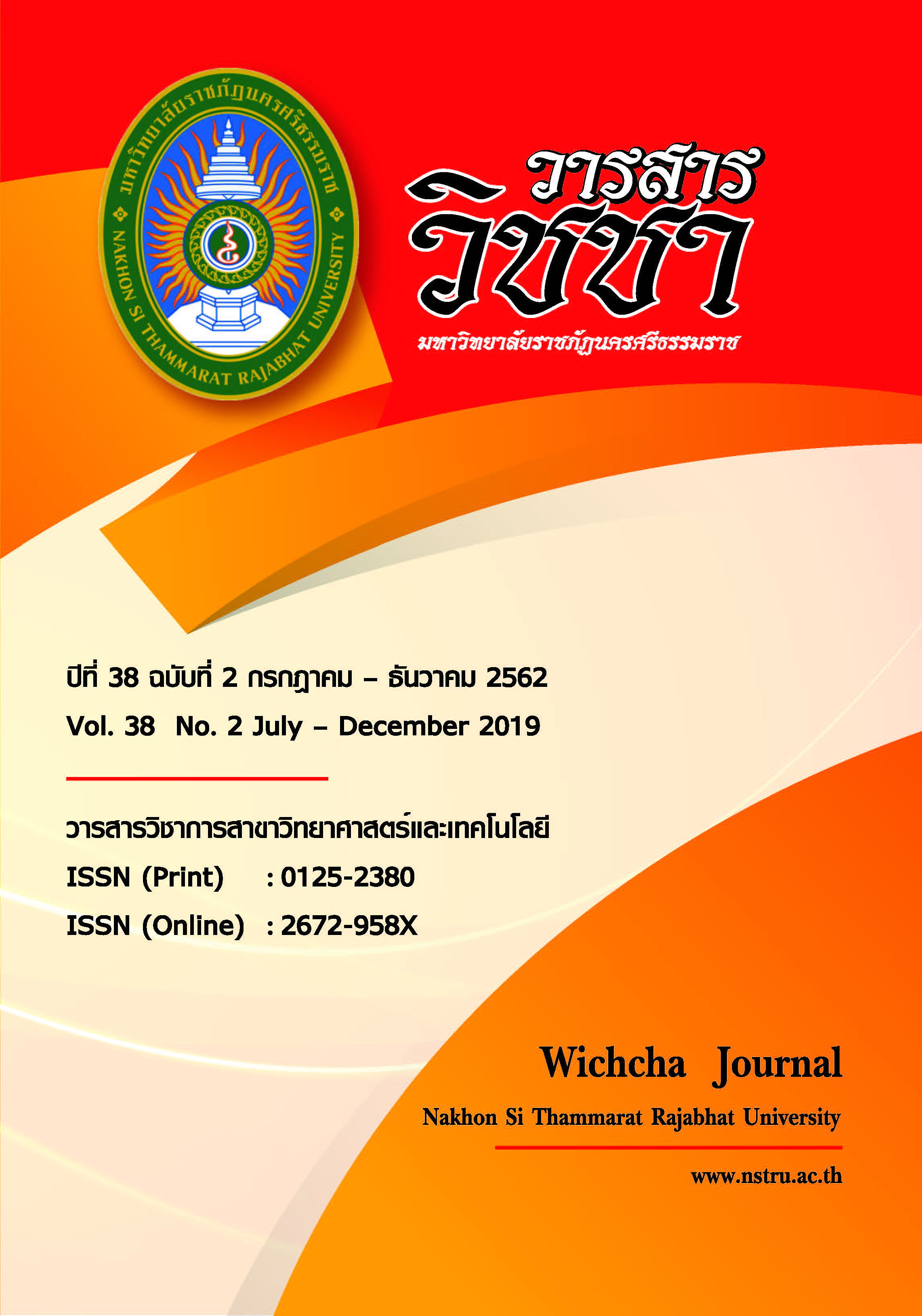Prevalence and Factors Associated to Cognitive Impairment among Elderly People in Chonnabot District, Khon Kaen Province ความชุกและปัจจัยที่มีความสัมพันธ์กับภาวะการรู้คิดบกพร่องของผู้สูงอายุ ในอำเภอชนบท จังหวัดขอนแก่น
Main Article Content
Abstract
This study was a cross-sectional analytical study aimed to assess the prevalence and associated factors with cognitive impairment among elderly people in Chonnabot district, Khon Kaen province. The samples consisted of 255 older people who were lived in Chonnabot district. The subjects were collected by multi-stage random sampling between Augusts to October 2017 by using a structural interview. The instruments consisted of 6 parts. For the validity testing (CVI) of the instruments had more than 0.80 and the reliability testing of the instruments by using the Alpha Coefficient’s of Cronbach had more than 0.70. Data were analyzed by using descriptive statistics and logistic regression. The results showed that the prevalence of cognitive impairment in elderly people was 42.7%. Factors significantly associated to cognitive impairment in elderly people were aged range 70-79 years (OR=2.20, 95% CI=1.27-7.06, p=0.004), aged > 80 years (OR=3.11, 95% CI=1.58-8.18, p=0.012), ≥ 3 of co-morbidity (OR=2.29, 95% CI=1.19-4.01, p=0.005), graduated from primary school (OR=3.10, 95% CI=1.13-8.13, p=0.001) and insufficiency of income (OR=3.80, 95% CI=1.56-8.88 p=0.001). The finding suggest that the healthcare provider should focus on factors influencing with cognitive impairment including age, co-morbidity and improving income and lead to planning and control by promoting the self-care knowledge about health problem especially the chronic diseases and promote the activity for improving income in order to reduce the cognitive impairment in elderly people.
Article Details
เนื้อหาและข้อมูลในบทความที่ลงตีพิมพ์ในวารสารวิชชา มหาวิทยาลัยราชภัฏนครศรีธรรมราช ถือเป็นข้อคิดเห็นและความรับผิดชอบของผู้เขียนบทความโดยตรง ซึ่งกองบรรณาธิการวารสารไม่จำเป็นต้องเห็นด้วยหรือร่วมรับผิดชอบใด ๆ
บทความ ข้อมูล เนื้อหา รูปภาพ ฯลฯ ที่ได้รับการตีพิมพ์ในวารสารวิชชา มหาวิทยาลัยราชภัฏนครศรีธรรมราช ถือเป็นลิขสิทธ์ของวารสารวิชชา มหาวิทยาลัยราชภัฏนครศรีธรรมราช หากบุคคลหรือหน่วยงานใดต้องการนำข้อมูลทั้งหมดหรือส่วนหนึ่งส่วนใดไปเผยแพร่ต่อหรือเพื่อการกระทำการใด ๆ จะต้องได้รับอนุญาตเป็นลายลักษณ์อักษรจากวารสารวิชชา มหาวิทยาลัยราชภัฏนครศรีธรรมราชก่อนเท่านั้น
The content and information in the article published in Wichcha journal Nakhon Si Thammarat Rajabhat University, It is the opinion and responsibility of the author of the article. The editorial journals do not need to agree. Or share any responsibility.
References
กรมการแพทย์กระทรวงสาธารณสุข. (2560). แบบประเมินความสามารถในการทำกิจวัตรประจำวัน. สืบค้นเมื่อ 8 สิงหาคม 2560, จาก: https://happynetwork.org/upload/forum/pic5552fe2898d4a.
จีราพร ทองดี ดาราวรรณ รองเมือง และฉันทนา นาคฉัตรีย์. (2555). ภาวะสุขภาพและคุณภาพชีวิตของผู้สูงอายุในจังหวัดชายแดนใต้. วารสารพยาบาลกระทรวงสาธารณสุข, 22(3), 88-99.
ชุติมา ทองวชิระ. (2559). ความชุกและปัจจัยที่มีความสัมพันธ์กับภาวะการรู้คิดบกพร่องในผู้สูงอายุในเขตบางพลัด กรุงเทพฯ. วิทยานิพนธ์พยาบาลศาสตรมหาบัณฑิต. มหาวิทยาลัยสวนดุสิต, กรุงเทพฯ.
ปิยะภร ไพรสนธิ์ และพรสวรรค์ เชื้อเจ็ดตน. (2560). ปัจจัยที่มีความสัมพันธ์กับภาวะการรู้คิดบกพร่องเล็กน้อยในผู้สูงอายุ จังหวัดเชียงราย. วารสารสภาการพยาบาล, 32(1), 64-80.
พวงผกา ชื่นแสงเนตร. (2538). ความสัมพันธ์ระหว่างสัมพันธภาพในครอบครัว พฤติกรรมการดูแลตนเอง และความพึงพอใจในชีวิต ของผู้สูงอายุ กรณีศึกษาสมาชิกชมรมผู้สูงอายุ เขตพื้นที่พัฒนาอุตสาหกรรมชายฝั่งทะเลตะวันตก จังหวัดชลบุรี. วิทยานิพนธ์วิทยาศาสตรมหาบัณฑิต. มหาวิทยาลัยมหิดล, นครปฐม.
วนิดา รัตนานนท์. (2545). ความสัมพันธ์ระหว่างปัจจัยพื้นฐาน ความสามารถในการดูแลตนเอง การสนับสนุนทางสังคม และคุณภาพชีวิตของผู้ป่วยมะเร็งเต้านมหลังผ่าตัด. วิทยานิพนธ์พยาบาลศาสตรมหาบัณฑิต. จุฬาลงกรณ์มหาวิทยาลัย, กรุงเทพฯ.
วรพรรณ เสนาณรงค์. (2554). แนวคิดเกี่ยวกับภาวะสมองเสื่อมในปัจจุบัน. วารสารประสาทวิทยาแห่งประเทศไทย, 1(1), 17-22.
วีรศักดิ์ เมืองไพศาล. (2556). การป้องกัน การประเมินและการดูแลผู้ป่วยสมองเสื่อม. กรุงเทพฯ: ภาพพิมพ์.
สมพร รัตนพันธ์. (2541). ปัจจัยที่เกี่ยวข้องกับภาวะจิตวิญญาณของผู้สูงอายุในโรงพยาบาล.วิทยานิพนธ์พยาบาลศาสตรมหาบัณฑิต. มหาวิทยาลัยสงขลานครินทร์, สงขลา.
สำนักงานสถิติแห่งชาติ. (2557). รายงานการสำรวจประชากรสูงอายุในประเทศไทย พ.ศ. 2557. (พิมพ์ครั้งที่ 5). กรุงเทพฯ: บริษัท เท็กซ์ แอนด์ เจอร์นัล พับลิเคชั่น จำกัด.
สำนักงานสาธารณสุขอำเภอชนบท (2560). สถิติประชากรในอำเภอชนบท. ขอนแก่น.
สถาบันวิจัยประชากรและสังคม มหาลัยมหิดล. (2559). ประชากรของประเทศไทย พ.ศ. 2560. สารประชากร มหาวิทยาลัยมหิดล, 25(1), 1-2.
Anstey, K.J., Sanden, C.V., Salim, A. and O’Kearney, R. (2008). Smoking as a risk factor for dementia and cognitive decline: A meta-analysis of prospective studies. American Journal of epidemiology, 166(4), 367-378.
Copper, C. (2015). Modifiable predictors of dementia in mild cognitive impairment:
a systematic review and meta-analysis. The American Journal of Psychiatry, 172(4), 323-334.
Daniel, W.W. (2014). Biostatistics: A foundation for analysis in the health sciences. New York: Wiley & Sons.
Deetong-on, T., Puapornpong, P., Pumipichet, S., Benyakorn, S., Kitporntheranunt, M. and Kongsomboon, K. (2013). Prevalence and risk factors of mild cognitive impairment in menopausal women at HRH Princess Maha Chakri Siridhorn Medical Center. Thai Journal of Obstetrics and Gynaecology, 21(3), 110-116.
Farias, S.T., Mungas, D., Reed, B.R., Harvey, D. and DeCarli, C. (2009). Progression of mild cognitive impairment to dementia in clinic- vs community-based cohorts. Archives of Neurology, 66(9), 1151-1157.
House, J.S. (1981). Work stress and social support. (2nd ed). Michigan: Reading, Mass Addison-Wesley Pub. Co.
Jenny, M. (2016). Factors associated with cognitive function in older adults in Mexico. Global Health Action, 9(1), 1-6.
Nakamura, K., Kitamura, K., Watanabe, Y., Shinoda, H., Sato, H. and Someya, T. (2016). Rural-urban differences in the prevalence of cognitive impairment in independent community-dwelling elderly residents of Ojiya city, Niigata Prefecture, Japan. Environmental Health and Preventive Medicine, 21(6), 422-429.
Petersen, R.C., Doody, R., Kurz, A., Mohs, R.C., Morris, J.C., Rabins, P.V., Ritchie, K., Rossor, M., Thal, L. and Winblad, B. (2001). Current concepts in mild cognitive impairment. Archives of Neurology, 58(12), 1985-1992.
Subindee, S. (2014). Mild cognitive impairment in older persons with chronic illness attended at a chronic care clinic of a primary care unit Khon Kaen Province. Journal of Nursing Science & Health, 37(1), 43-50.
Train the brain forum committee. (1993). Thai mental state examination. Siriraj Medical Journal, 45(6), 359-374.
Ward, A., Arrighi, H.M., Michels, S. and Cedarbaum, J.M. (2012). Mild cognitive impairment: Disparity of incidence and prevalence estimates. The Journal of the Alzheimer's Association, 8(1), 14-21.


